Facts about Squid
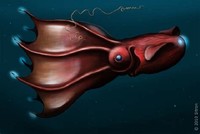
The vampire squid is more closely related to the octopuses than to any of the squid, and is generally placed in its own order, Vampyromorphida, in the superorder Octopodiformes.

Squids usually have two elongated tentacles especially for the capture of food.

Squids are marine cephalopods (class Cephalopoda, phylum Mollusca) with ten arms and tentacles (at some point in life), secondary armature on their suckers, and lacking the internal shell specific to cuttlefish.

The teeth of the giant squid are small, "bottle-cap" shaped circular saws, while the tentacles of the colossal squid wield two long rows of thick, sharp, finger-length screws of protruding bone.

Captured whales, which consume squid, often have squid beaks in their stomachs, the beak being the only indigestible part of the squid.

Squids differ from the squid-like cuttlefish in that cuttlefish have an internal shell (cuttlebone) on their back.

Squids have a specialized foot called the siphon, or hyponome, that enables them to move by expelling water under pressure.
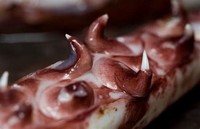
The suckers of squids also have hooks and/or sucker rings, while octopuses have simple suckers without secondary armature (O'Shea 2006).

Like all cephalopods, squids are characterized by bilateral symmetry, a prominent head, and a modification of the mollusk foot into the form of arms or tentacles surrounding the mouth, which has beak-like jaws.
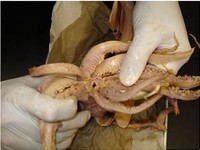
The mouth of the squid is equipped with a sharp horny beak made of chitin, used to kill and tear prey into manageable pieces.
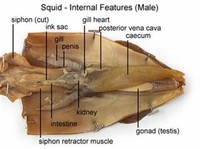
Squids have two gills, sometimes called ctenidia, and an extensive closed circulatory system consisting of a systemic heart and two gill hearts.

Giant squids are featured in literature and folklore, with a strongly frightening connotation.

Squids are exclusively carnivorous, feeding on fish and other invertebrates.

In 2003, however, a large specimen of an abundant but poorly understood species Mesonychoteuthis hamiltoni (the colossal squid) was discovered.

Individual species of squid are found abundantly in certain areas and provide large catches for fisheries.

Two other orders of decapodiform cephalopods are also called squid, although they are taxonomically distinct from Teuthida and differ recognizably in their gross anatomical features.
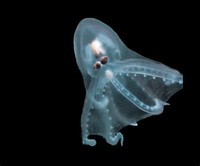
Some cephalopods whose common name includes "squid" (bobtail squid, ram's horn squid, vampire squid) are taxonomically different.

The tentacles and the ink are also edible; in fact, the only parts of the squid that are not eaten are its beak and the internal bony structure.

Squids are the most skilled of the coleoids at this form of jet propulsion.

Squids belong to the subclass Coleoidea along with octopuses, cuttlefish, and extinct belemites.
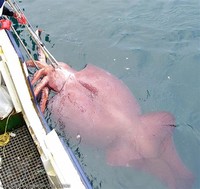
The size of Mesonychoteuthis hamiltoni, considered to be the largest squid, is based on estimates.

Squids also offer aesthetic value, as a popular item in public aquariums and as a focal point in movies and literature.

Many species of squid are popular as food in cuisines as widely separated as Korean and Italian.

Squid have chromatophores (pigment-containing and light-reflecting cells) embedded in their skin in the outer layer of mantle and they can change color and readily blend in with their surroundings to avoid predators.
Squid mainly eat crustaceans, crab, shrimp, orange roughy, hokie, oysters, lantern fish, and other small fish. They are known to be cannibals. They often prey on other smaller squid for food, although only in extreme situations.
Once they grow up, Humboldt squid are too large to be eaten by the predators that stalked them when they were young, but there are plenty of larger predators out there. Tuna, sharks, dolphins, and especially sperm whales love to chow down on Humboldt squid.
